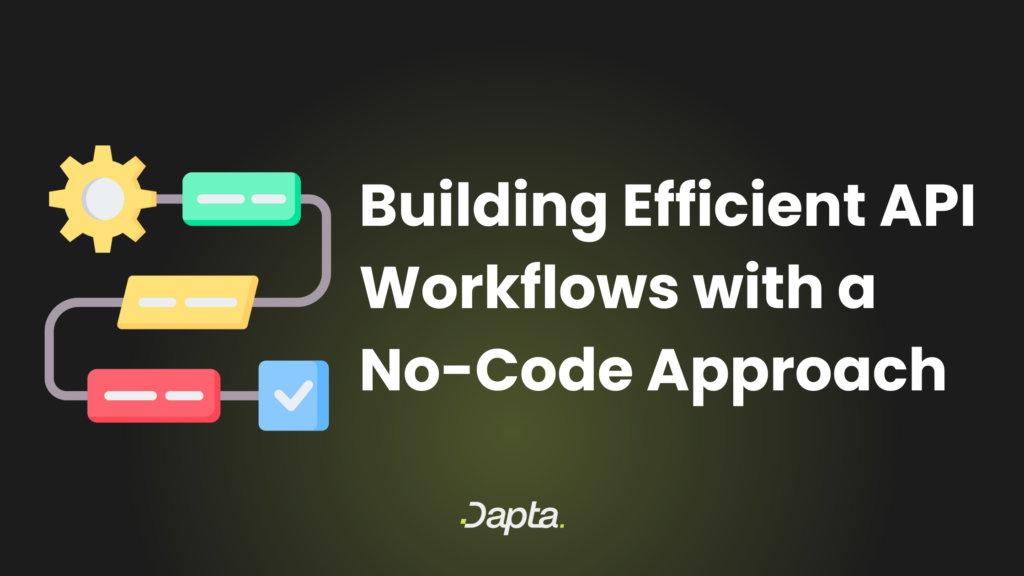Building Efficient API Workflows with a No-Code Approach

As the digital landscape evolves, the demand for rapid development and deployment of applications is at an all-time high. In this fast-paced environment, no-code solutions have emerged as a game-changer, especially when it comes to API workflows. No-code platforms empower technical users to construct, manage, and optimize API workflows without the traditional barriers of coding. Dapta’s no-code backend platform stands at the forefront of this revolution, offering a seamless and powerful way to handle backend operations. Learn more about how Dapta is changing the game in backend operations by visiting Dapta’s website.
For technical users who may have reservations about the capabilities and limitations of no-code solutions, Dapta offers a compelling argument. It combines ease of use with the robustness required for complex backend tasks. By leveraging Dapta’s platform, users can connect to any data source, build custom API integrations, and deploy business logic with unprecedented speed and efficiency.
Understanding No-Code API Workflows
No-code API workflows are about simplifying the process of API integration and management. They allow users to create custom APIs that serve their specific business needs without writing a single line of code. This approach not only accelerates development timelines but also democratizes access to technology, enabling users with varying levels of technical expertise to contribute to a project’s success.
At the core of Dapta’s no-code API workflows are native connectors that support a wide array of data sources. Whether it’s databases, spreadsheets, or flat files, Dapta’s connectors facilitate seamless data aggregation and transformation. This capability is akin to a no-code ETL (Extract, Transform, Load) solution, but with a more potent and flexible edge.
With Dapta, building API integrations is intuitive. The platform’s no-code API builder allows for the creation of custom endpoints that can incorporate complex business logic. This is particularly advantageous for technical users who seek to maintain control over their systems’ functionality without the overhead of coding.
Moreover, Dapta provides general use templates that serve as a starting point for customization. These templates can be tailored to fit the unique requirements of a company, offering a blend of standardization and personalization.
Breaking Down Technical User Objections
One of the primary concerns for technical users when considering no-code solutions is the potential loss of control and flexibility. However, Dapta’s platform is designed to address these concerns head-on. By offering the ability to create custom workflows and logic, Dapta ensures that users do not have to compromise on the sophistication of their backend systems.
Another common objection is the question of scalability. Can a no-code platform handle the growth and complexity of a burgeoning enterprise? Dapta answers this with a resounding yes. The platform is built to be fast and scalable, capable of adapting to the changing needs of a business.
Security is also a top priority for technical users. Dapta’s commitment to security is evident in its robust infrastructure, which includes secure connections and compliance with industry standards. This ensures that while the development process may be simplified, the integrity and protection of data are never compromised.
Finally, there’s the issue of integration with existing systems. Dapta’s platform excels in this area by providing connectors that enable users to integrate with virtually any API or data source. This flexibility ensures that adopting a no-code approach does not mean starting from scratch but rather enhancing and streamlining existing processes.
Maximizing Efficiency with Dapta’s No-Code Platform
Dapta’s no-code platform is not just about ease of use; it’s about maximizing efficiency. By reducing the time and resources required for API workflow development, Dapta enables technical teams to focus on innovation and strategy rather than getting bogged down in the minutiae of coding.
The platform’s visual interface allows for rapid prototyping and iteration, making it possible to test and refine APIs in real-time. This immediate feedback loop is invaluable for technical users who are accustomed to the iterative nature of development.
In addition, Dapta’s platform fosters collaboration among team members with different skill sets. By removing the barrier of code, teams can work together more effectively, combining their expertise to create more robust and innovative solutions.
Ultimately, Dapta’s no-code API workflows represent a paradigm shift in backend development. They offer a powerful alternative to traditional coding that does not sacrifice functionality or control. For technical users looking to stay ahead of the curve, embracing no-code API workflows is not just a convenience; it’s a strategic imperative.
Conclusion
The rise of no-code API workflows marks a significant milestone in the evolution of backend development. Dapta’s platform embodies this advancement, providing technical users with the tools they need to build efficient, scalable, and secure API workflows. By embracing a no-code approach, technical users can overcome common objections and unlock new levels of productivity and innovation.
As we look to the future, the importance of agility and adaptability in technology cannot be overstated. No-code solutions like Dapta’s are leading the charge, empowering users to create complex systems with ease and confidence. It’s time to leap ahead in innovation with efficient API workflows, and Dapta is the perfect partner for that journey.
